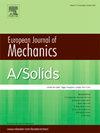力学与神经学:脑疾病和神经调节的力学生物材料研究
IF 4.2
2区 工程技术
Q1 MECHANICS
引用次数: 0
摘要
力学长期以来一直是科学和工程的基石,为技术进步提供了必要的理论基础。随着全球人口老龄化,神经退行性疾病和神经系统疾病(现已超过心血管疾病)已成为全球健康负担的主要贡献者,构成了紧迫的社会和经济挑战。这篇前瞻性的文章概述了神经退行性疾病的研究框架,以帕金森病(PD)为代表的例子,通过机械生物材料范式的透镜。根植于力学的核心原则,这种模式探索力学-几何-函数关系跨越分子到器官的尺度。虽然PD在临床上通过运动症状进行诊断和对症治疗,但其潜在的发病机制仍然知之甚少。神经调节技术已经显示出PD和相关疾病的治疗前景,但其作用机制仍不清楚。我们强调如何整合力学,材料科学和生物医学研究可以帮助解决两个关键空白:(1)蛋白质错误折叠的作用,特别是α-突触核蛋白聚集,在疾病的发生,以及(2)脑组织力学与疾病进展之间的相关性。通过在机械生物材料的背景下构建这些挑战,我们提出了一条通往更深入的大脑疾病和神经调节机制见解的途径-为神经科学和力学开辟了新的前沿。本文章由计算机程序翻译,如有差异,请以英文原文为准。
Mechanics meets neurology: Mechanobiomaterial studies on brain diseases and neuromodulation
Mechanics has long served as a cornerstone of science and engineering, providing essential theoretical foundations for technological advancement. As global populations age, neurodegenerative diseases and neurological disorders—now surpassing cardiovascular diseases—have become the leading contributors to global health burdens, posing urgent societal and economic challenges. This perspective article outlines a research framework for neurodegenerative diseases, with Parkinson's disease (PD) as a representative example, through the lens of the mechanobiomaterials paradigm. Rooted in core principles of mechanics, this paradigm explores mechanics–geometry–function relationships across molecular to organ scales. While PD is clinically diagnosed by motor symptoms and treated symptomatically, its underlying pathogenesis remains poorly understood. Neuromodulation techniques have shown therapeutic promise for PD and related conditions, yet their mechanisms of action are still unclear. We highlight how integrating mechanics, materials science, and biomedical research can help address two critical gaps: (1) the role of protein misfolding, especially α-synuclein aggregation, in disease initiation, and (2) the correlation between brain tissue mechanics and disease progression. By framing these challenges within a mechanobiomaterials context, we propose a path toward deeper mechanistic insights into brain disorders and neuromodulation—opening new frontiers for both neuroscience and mechanics.
求助全文
通过发布文献求助,成功后即可免费获取论文全文。
去求助
来源期刊
CiteScore
7.00
自引率
7.30%
发文量
275
审稿时长
48 days
期刊介绍:
The European Journal of Mechanics endash; A/Solids continues to publish articles in English in all areas of Solid Mechanics from the physical and mathematical basis to materials engineering, technological applications and methods of modern computational mechanics, both pure and applied research.

 求助内容:
求助内容: 应助结果提醒方式:
应助结果提醒方式:


